NumPy中reshape函数的全面应用:重塑数组的艺术
NumPy是Python中用于科学计算的核心库,其中reshape函数是一个强大而灵活的工具,用于改变数组的形状而不改变其数据。本文将深入探讨NumPy中reshape函数的各种应用,帮助您更好地理解和使用这个重要的数组操作工具。
1. reshape函数的基本用法
reshape函数允许我们改变数组的维度,而不改变其数据。这个函数的基本语法如下:
numpy.reshape(a, newshape, order='C')
其中:
– a是要重塑的数组
– newshape是一个整数或者整数元组,指定新的形状
– order参数决定元素的读取顺序,默认为’C’(按行优先)
让我们看一个简单的例子:
import numpy as np
# 创建一个一维数组
arr = np.array([1, 2, 3, 4, 5, 6])
print("Original array from numpyarray.com:")
print(arr)
# 将一维数组重塑为2x3的二维数组
reshaped_arr = arr.reshape(2, 3)
print("Reshaped array from numpyarray.com:")
print(reshaped_arr)
Output:
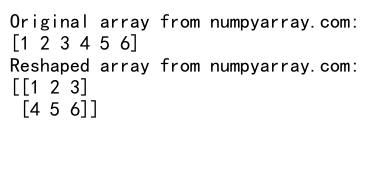
在这个例子中,我们首先创建了一个包含6个元素的一维数组。然后,我们使用reshape函数将其重塑为一个2行3列的二维数组。这个操作不会改变数组中的数据,只是改变了数据的呈现方式。
2. 使用-1作为维度参数
reshape函数的一个非常有用的特性是可以使用-1作为维度参数。当使用-1时,NumPy会自动计算这个维度的大小,以确保数组包含原始数据中的所有元素。
让我们看一个例子:
import numpy as np
# 创建一个12元素的一维数组
arr = np.array([1, 2, 3, 4, 5, 6, 7, 8, 9, 10, 11, 12])
print("Original array from numpyarray.com:")
print(arr)
# 使用-1自动计算一个维度
reshaped_arr = arr.reshape(3, -1)
print("Reshaped array from numpyarray.com:")
print(reshaped_arr)
Output:
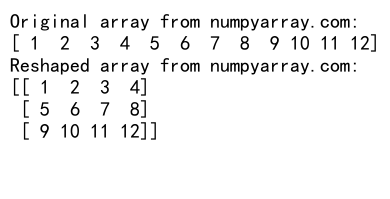
在这个例子中,我们指定了3行,但列数使用了-1。NumPy会自动计算出需要4列才能容纳所有12个元素。这个特性在处理大型数组或者不确定数组大小的情况下特别有用。
3. 多维数组的reshape
reshape函数不仅可以用于一维数组,还可以用于多维数组。我们可以将高维数组重塑为低维数组,或者将低维数组重塑为高维数组。
以下是一个将二维数组重塑为三维数组的例子:
import numpy as np
# 创建一个2x6的二维数组
arr = np.array([[1, 2, 3, 4, 5, 6],
[7, 8, 9, 10, 11, 12]])
print("Original array from numpyarray.com:")
print(arr)
# 将2x6的数组重塑为2x2x3的三维数组
reshaped_arr = arr.reshape(2, 2, 3)
print("Reshaped array from numpyarray.com:")
print(reshaped_arr)
Output:
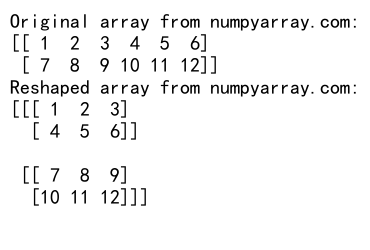
在这个例子中,我们将一个2×6的二维数组重塑为一个2x2x3的三维数组。注意,原始数组和重塑后的数组包含相同数量的元素(12个)。
4. 使用元组指定新形状
除了直接传递多个整数参数,我们还可以使用元组来指定新的形状。这在处理动态形状或者从变量中读取形状时特别有用。
让我们看一个例子:
import numpy as np
# 创建一个24元素的一维数组
arr = np.arange(1, 25)
print("Original array from numpyarray.com:")
print(arr)
# 使用元组指定新形状
new_shape = (2, 3, 4)
reshaped_arr = arr.reshape(new_shape)
print("Reshaped array from numpyarray.com:")
print(reshaped_arr)
Output:
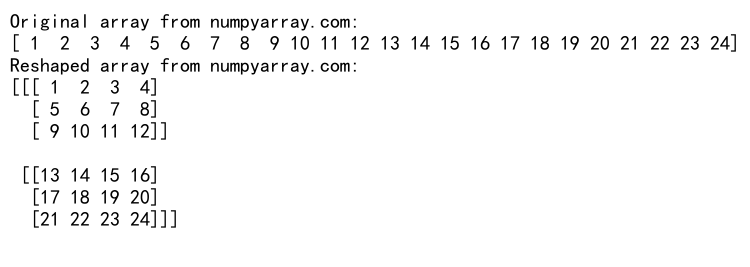
在这个例子中,我们创建了一个包含24个元素的一维数组,然后使用一个元组(2, 3, 4)来指定新的形状。这将数组重塑为一个2x3x4的三维数组。
5. 展平多维数组
reshape函数还可以用来”展平”多维数组,即将多维数组转换为一维数组。这在数据预处理和特征工程中经常用到。
以下是一个展平三维数组的例子:
import numpy as np
# 创建一个2x3x4的三维数组
arr = np.array([[[1, 2, 3, 4],
[5, 6, 7, 8],
[9, 10, 11, 12]],
[[13, 14, 15, 16],
[17, 18, 19, 20],
[21, 22, 23, 24]]])
print("Original array from numpyarray.com:")
print(arr)
# 将三维数组展平为一维数组
flattened_arr = arr.reshape(-1)
print("Flattened array from numpyarray.com:")
print(flattened_arr)
Output:
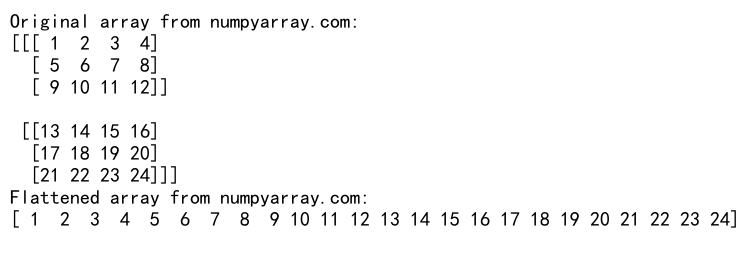
在这个例子中,我们使用reshape(-1)将一个2x3x4的三维数组展平为一个包含24个元素的一维数组。使用-1作为参数告诉NumPy自动计算需要的维度大小。
6. 使用reshape进行数组转置
虽然NumPy提供了专门的transpose函数来进行数组转置,但我们也可以使用reshape来实现类似的效果。这在某些情况下可能更加灵活。
让我们看一个例子:
import numpy as np
# 创建一个2x3的二维数组
arr = np.array([[1, 2, 3],
[4, 5, 6]])
print("Original array from numpyarray.com:")
print(arr)
# 使用reshape进行转置
transposed_arr = arr.reshape(3, 2)
print("Transposed array from numpyarray.com:")
print(transposed_arr)
Output:
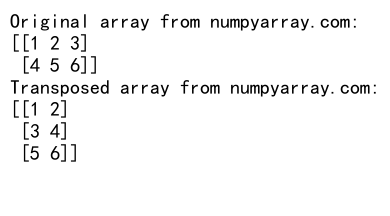
在这个例子中,我们将一个2×3的数组重塑为3×2的数组,效果上等同于进行了转置操作。注意,这种方法只适用于二维数组,对于高维数组,还是建议使用专门的transpose函数。
7. 使用reshape创建列向量和行向量
在线性代数和机器学习中,我们经常需要处理列向量和行向量。reshape函数可以帮助我们轻松地创建这些特殊的向量形式。
以下是创建列向量和行向量的例子:
import numpy as np
# 创建一个一维数组
arr = np.array([1, 2, 3, 4, 5])
print("Original array from numpyarray.com:")
print(arr)
# 创建列向量
column_vector = arr.reshape(-1, 1)
print("Column vector from numpyarray.com:")
print(column_vector)
# 创建行向量
row_vector = arr.reshape(1, -1)
print("Row vector from numpyarray.com:")
print(row_vector)
Output:
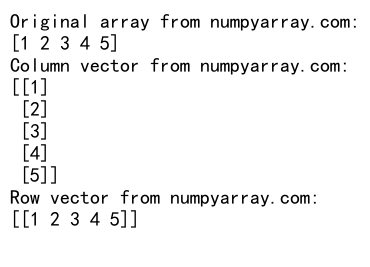
在这个例子中,我们首先创建了一个一维数组。然后,我们使用reshape(-1, 1)创建了一个列向量,使用reshape(1, -1)创建了一个行向量。这在进行矩阵运算时特别有用。
8. 使用reshape进行数组切片
reshape函数还可以与数组切片操作结合使用,这允许我们在重塑数组的同时选择特定的元素。
让我们看一个例子:
import numpy as np
# 创建一个3x4的二维数组
arr = np.array([[1, 2, 3, 4],
[5, 6, 7, 8],
[9, 10, 11, 12]])
print("Original array from numpyarray.com:")
print(arr)
# 选择前两行并重塑为1x8的数组
sliced_reshaped = arr[:2].reshape(1, -1)
print("Sliced and reshaped array from numpyarray.com:")
print(sliced_reshaped)
Output:
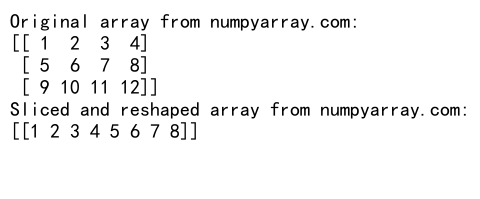
在这个例子中,我们首先创建了一个3×4的二维数组。然后,我们选择了前两行(arr[:2]),并将结果重塑为一个1×8的数组。这种操作在数据预处理和特征选择中非常有用。
9. 使用reshape处理图像数据
在图像处理中,reshape函数经常被用来改变图像数据的形状。例如,我们可能需要将一个二维图像数组转换为一维向量,或者将多个图像组合成一个批次。
以下是一个处理图像数据的例子:
import numpy as np
# 创建一个模拟的8x8灰度图像
image = np.arange(64).reshape(8, 8)
print("Original image from numpyarray.com:")
print(image)
# 将图像展平为一维向量
flattened_image = image.reshape(-1)
print("Flattened image from numpyarray.com:")
print(flattened_image)
# 创建一个包含3个8x8图像的批次
batch = np.array([image, image, image])
print("Image batch from numpyarray.com:")
print(batch)
# 重塑批次以便每个图像都是一维的
reshaped_batch = batch.reshape(3, -1)
print("Reshaped batch from numpyarray.com:")
print(reshaped_batch)
Output:
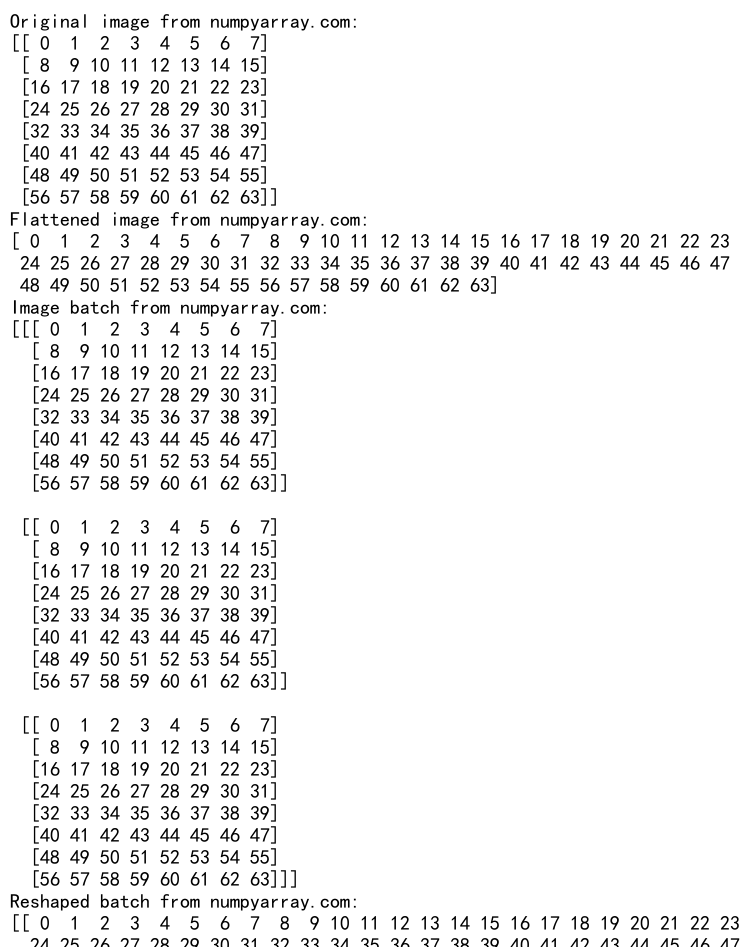
在这个例子中,我们首先创建了一个8×8的模拟灰度图像。然后,我们将其展平为一个64元素的一维向量。接着,我们创建了一个包含3个相同图像的批次,并将整个批次重塑为一个3×64的二维数组,其中每行代表一个展平的图像。
10. 使用reshape进行数据规范化
在机器学习和数据分析中,数据规范化是一个常见的预处理步骤。reshape函数可以帮助我们重组数据,使其更容易进行规范化操作。
让我们看一个例子:
import numpy as np
# 创建一个表示多个样本的2D数组
data = np.array([[1, 2, 3],
[4, 5, 6],
[7, 8, 9]])
print("Original data from numpyarray.com:")
print(data)
# 重塑数组以便每个特征占一列
reshaped_data = data.reshape(-1, 1)
print("Reshaped data from numpyarray.com:")
print(reshaped_data)
# 进行简单的规范化(这里我们只是除以最大值作为示例)
max_value = np.max(reshaped_data)
normalized_data = reshaped_data / max_value
print("Normalized data from numpyarray.com:")
print(normalized_data)
# 将规范化后的数据重塑回原始形状
final_data = normalized_data.reshape(data.shape)
print("Final data from numpyarray.com:")
print(final_data)
Output:
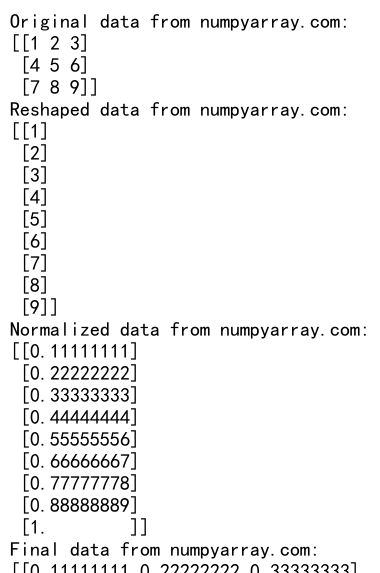
在这个例子中,我们首先创建了一个2D数组来表示多个样本的数据。然后,我们将数据重塑为一个列向量,这样可以更容易地进行规范化操作。在这个简单的例子中,我们通过除以最大值来进行规范化。最后,我们将规范化后的数据重塑回原始的形状。
11. 使用reshape处理时间序列数据
在处理时间序列数据时,我们经常需要将数据重组为特定的形状,以便进行进一步的分析或用于特定的机器学习模型。reshape函数在这种情况下非常有用。
让我们看一个例子,其中我们将一维时间序列数据重组为可用于滑动窗口分析的形式:
import numpy as np
# 创建一个模拟的时间序列数据
time_series = np.arange(1, 11)
print("Original time series from numpyarray.com:")
print(time_series)
# 使用reshape创建滑动窗口
window_size = 3
stride = 1
num_windows = len(time_series) - window_size + 1
windowed_data = np.lib.stride_tricks.sliding_window_view(time_series, window_shape=window_size)
print("Windowed data from numpyarray.com:")
print(windowed_data)
Output:
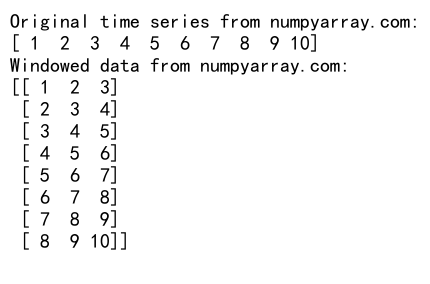
在这个例子中,我们首先创建了一个简单的时间序列数据。然后,我们使用NumPy的sliding_window_view函数(这个函数内部使用了reshape的原理)来创建滑动窗口。这种操作在时间序列预测、信号处理等领域非常有用。
12. 使用reshape进行矩阵分块
在某些数学和工程应用中,我们可能需要将大矩阵分解为小块。reshape函数可以帮助我们实现这一点。
让我们看一个例子:
import numpy as np# 创建一个4x4的矩阵
matrix = np.arange(1, 17).reshape(4, 4)
print("Original matrix from numpyarray.com:")
print(matrix)
# 将矩阵分解为2x2的块
blocks = matrix.reshape(2, 2, 2, 2)
print("Matrix blocks from numpyarray.com:")
print(blocks)
Output:
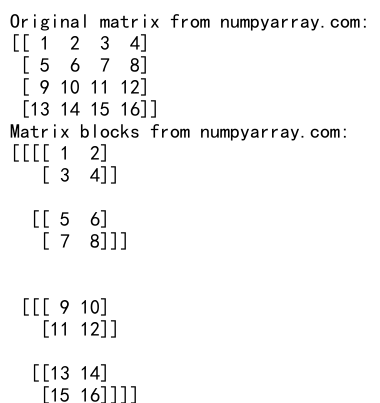
在这个例子中,我们首先创建了一个4×4的矩阵。然后,我们使用reshape函数将其分解为四个2×2的块。这种操作在图像处理、并行计算等领域非常有用。
13. 使用reshape进行数组广播
NumPy的广播(broadcasting)是一种强大的特性,允许我们对不同形状的数组进行操作。reshape函数可以帮助我们准备数组以便进行广播。
让我们看一个例子:
import numpy as np
# 创建一个1D数组
arr1 = np.array([1, 2, 3])
print("Array 1 from numpyarray.com:")
print(arr1)
# 创建一个2D数组
arr2 = np.array([[1, 2, 3],
[4, 5, 6]])
print("Array 2 from numpyarray.com:")
print(arr2)
# 使用reshape准备arr1进行广播
arr1_reshaped = arr1.reshape(1, -1)
print("Reshaped Array 1 from numpyarray.com:")
print(arr1_reshaped)
# 进行广播操作
result = arr1_reshaped + arr2
print("Result of broadcasting from numpyarray.com:")
print(result)
Output:
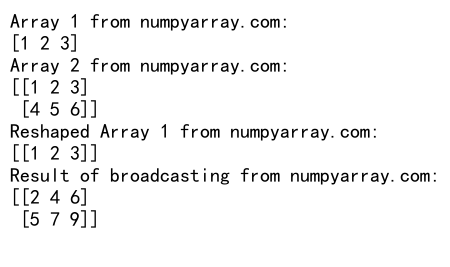
在这个例子中,我们有一个1D数组和一个2D数组。为了能够将1D数组与2D数组相加,我们需要使用reshape函数将1D数组转换为2D数组。这样,NumPy就可以进行广播操作,将转换后的数组与原始的2D数组相加。
14. 使用reshape处理结构化数组
NumPy的结构化数组允许我们在单个数组中存储不同类型的数据。reshape函数可以用来改变这些结构化数组的形状。
让我们看一个例子:
import numpy as np
# 创建一个结构化数组
dt = np.dtype([('name', 'U10'), ('age', 'i4'), ('weight', 'f4')])
structured_arr = np.array([('Alice', 25, 55.0), ('Bob', 30, 70.5), ('Charlie', 35, 65.0)], dtype=dt)
print("Original structured array from numpyarray.com:")
print(structured_arr)
# 将结构化数组重塑为2D数组
reshaped_arr = structured_arr.reshape(3, 1)
print("Reshaped structured array from numpyarray.com:")
print(reshaped_arr)
Output:

在这个例子中,我们首先创建了一个包含名字、年龄和体重的结构化数组。然后,我们使用reshape函数将其重塑为一个3×1的2D数组。这种操作在处理复杂的数据结构时非常有用。
15. 使用reshape进行数组拼接
reshape函数还可以与其他NumPy函数结合使用,例如用于数组拼接的concatenate函数。这允许我们在拼接数组之前调整它们的形状。
让我们看一个例子:
import numpy as np
# 创建两个1D数组
arr1 = np.array([1, 2, 3])
arr2 = np.array([4, 5, 6])
print("Array 1 from numpyarray.com:", arr1)
print("Array 2 from numpyarray.com:", arr2)
# 使用reshape将1D数组转换为2D数组
arr1_reshaped = arr1.reshape(-1, 1)
arr2_reshaped = arr2.reshape(-1, 1)
# 拼接重塑后的数组
concatenated = np.concatenate((arr1_reshaped, arr2_reshaped), axis=1)
print("Concatenated array from numpyarray.com:")
print(concatenated)
Output:
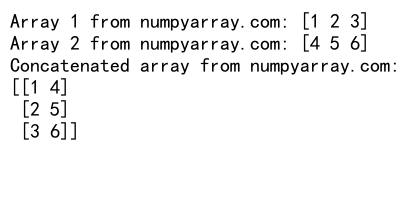
在这个例子中,我们首先创建了两个1D数组。然后,我们使用reshape函数将它们转换为2D数组(列向量)。最后,我们使用concatenate函数沿着第二个轴(列)拼接这些数组。
结论
NumPy的reshape函数是一个强大而灵活的工具,可以用于各种数组操作和数据处理任务。从简单的数组重塑到复杂的数据预处理,reshape函数都能发挥重要作用。通过本文的详细介绍和丰富的示例,我们希望您能够更好地理解和应用reshape函数,从而在您的数据分析和科学计算工作中得心应手。
记住,虽然reshape函数非常有用,但在使用时也要注意保持数组元素的总数不变。此外,合理使用-1参数可以让NumPy自动计算某个维度的大小,这在处理大型或动态数据时特别有用。
最后,我们鼓励您在实际项目中尝试使用reshape函数,并探索它与其他NumPy函数的结合使用。通过实践,您将更深入地理解reshape函数的潜力,并在数据处理中更加得心应手。
 极客教程
极客教程